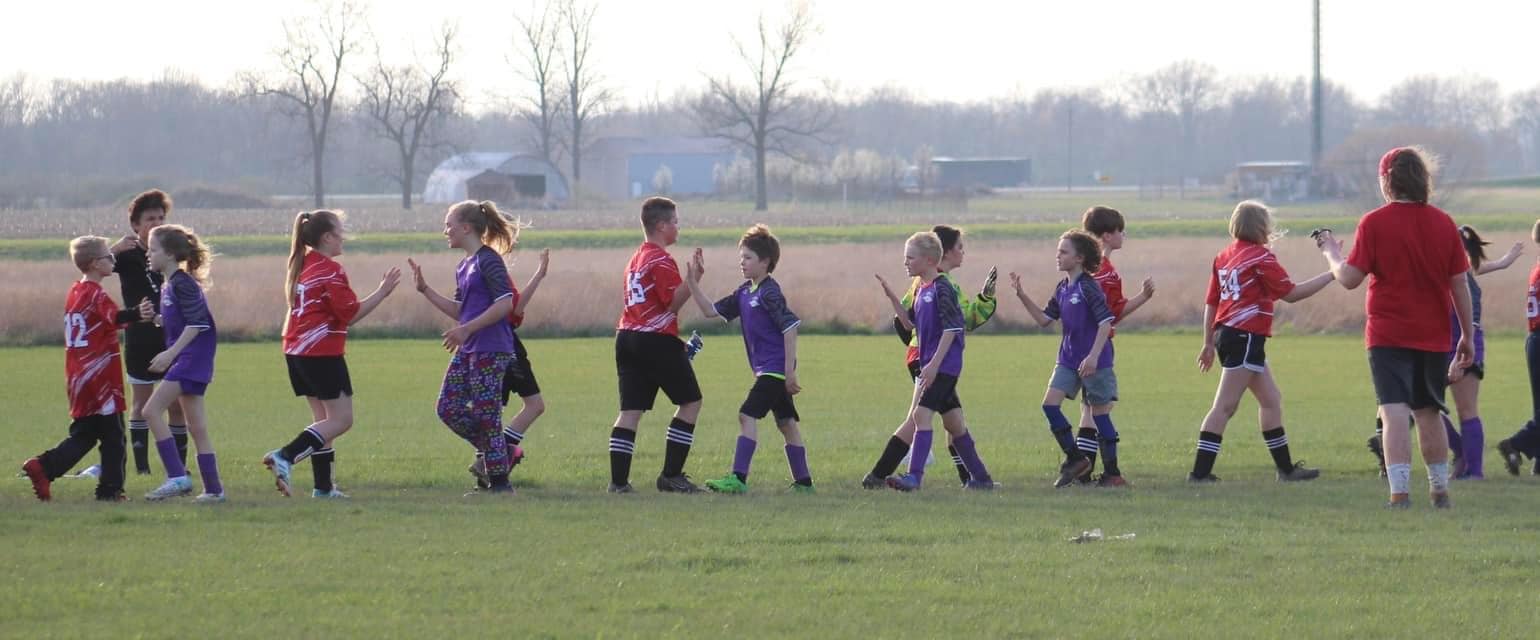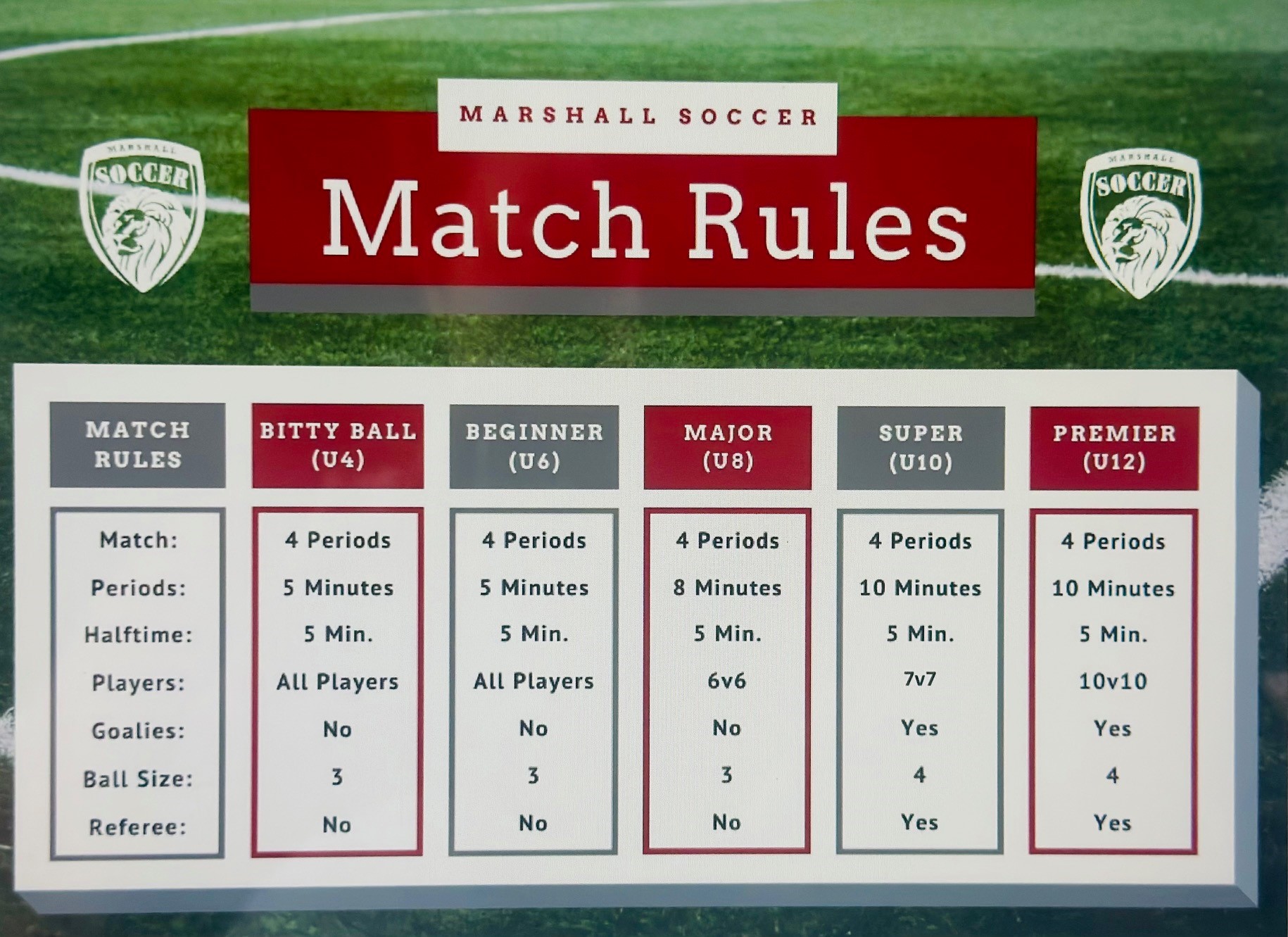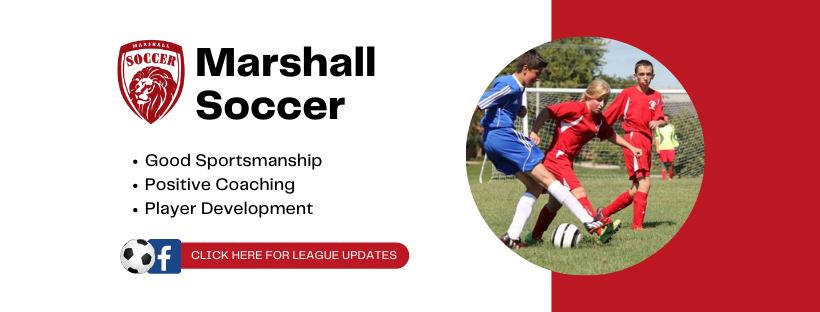
League Rules
- Coaches should bring a game ball to all matches
- We will provide coaches access to the soccer shed
- Home team needs to put out the flags if you are the first game (each age group)
- Home team needs to put flags back in the shed if you are the last game on your field (each age group)
- Fields should be painted before you arrive, if not, please stripe your field
- Please call your player's family members for the first contact. Some parents may not text or email and need a phone call.
- Use a team management app like the Remind App to contact your team for practice or game changes and announcements.
- We will set up a group text message for each division. Please use this for any correspondence about games. This is what we will use to contact you during the season.
- Lets have fun. If your team is winning big, have them work on passing skills prior to shooting on goal.

________________________________________
Division Rules
Bitty Ball (U4) Rules
Game Time: 30 Minutes Total
Players: All kids play at the same time.
Goalies: No
Ball Size: 3
Field Size: 50' long x 30' wide
Referee: No, coaches must referee.
Focus: Have fun and encourage players to come back next season! Work on learning how to keep the ball in the field of play. Learn to kick and not use hands. Rules are loose with no score kept. Be silly with your players on the field. Invite parents to come out and help as much as possible. The main objective is to HAVE FUN!!!!
Other: No headers, no slide tackles, no offsides, no penalty kicks, no direct kicks, no throw-ins.
________________________________________
Beginner (U6) Rules
Game Time: 4 Periods
Period Length: 5 Minutes each
Halftime Length: 5 Minutes
Players: All kids play at the same time.
Goalies: No
Ball Size: 3
Field Size: 140' long x 82' wide
Referee: No, coaches must referee.
Coaches: On the field during matches.
Focus: Have fun and encourage players to come back next season! The division will work on structured kickoffs (starting the game with a pass), keeping the ball in the field of play, dribbling, overhead throw-ins, and moving the ball in the right direction without using their hands.
Other: No headers, no slide tackles, no offsides, no penalty kicks, no direct kicks.
________________________________________
Major (U8) Rules
Game Time: 4 Periods
Period Length: 8 Minutes each
Halftime Length: 5 Minutes
Players: 6 vs 6
Goalies: No
Ball Size: 3
Field Size: 140' long x 82' wide
Referee: No, coaches must referee.
Coaches: On the field during matches.
Focus: The division will work on structured kickoffs (starting the game with a pass), keeping the ball in the field of play, dribbling, and overhead throw-ins.
This division will introduce a 2/2/2 formation. Thus, teams are allowed two defenders.
No players (including defenders) are allowed in the box during the game.
Kids are subbed out in the middle of each period for equal playing time. This is not a timeout, just run in the subs when the ball goes out of bounds.
Other: No headers, no slide tackles, no offsides, no penalty kicks and no direct kicks.
________________________________________
Super (U10) Rules
Game Time: 4 Periods
Period Length: 10 Minutes each
Halftime Length: 5 Minutes
Players: 7 vs 7 (includes goalies)
Goalies: Yes
Ball Size: 4
Referee: Yes
Coaches: On sidelines during matches.
Focus: Learning all positions on the field. Players are allowed inside the goal box. Focus on technique (passing, dribbling, throw-ins). Coaches will teach and stress offsides. Coaches AND officials to police offsides rules. Penalty kicks for obvious fouls.
Other: No headers and no slide tackles. Direct kicks are allowed, but no walls.
Sub on dead balls. Subs should wait on the midline to be subbed in the game.
________________________________________
Premier (U12) Rules
Game Time: 2 Periods
Period Length: 30 Minutes each
Halftime Length: 5 Minutes
Players: 10 vs 10 (includes goalies)
Goalies: Yes
Ball Size: 4
Referee: Yes
Coaches: On sidelines during matches.
Focus: Players should start specializing in a position but be able to play others as well.
Other: No headers, no slide tackles.
Sub on dead balls. Subs should wait on the midline to be subbed in the game.
________________________________________
JH/HS Rules
Marshall Soccer follows all IHSA Soccer rules for Junior High & High School matches. Click the link below to view rules:
Player Safety: Marshall Soccer has pledged to follow the guidelines of the Safer Soccer campaign by the Concussion Legacy Foundation by delaying the use of heading until high school. All coaches will receive information from the Head's Up! campaign by the Centers of Disease Control about the risk and prevention of concussions in youth sports. If a coach feels that there is any potential of a head injury based on the CDC Heads Up! program they are required to remove the child for the rest of the game. If a coach believes a child is showing symptoms of a concussion, they will provide the family with educational materials from the Heads Up! program.
Uniforms/Equipment: All players on a team are required to wear the same-colored jerseys. During games on cold days please wear additional layers under the jersey. Goalkeepers must wear colors which distinguish him/her from the other players and referees. Players are required to wear shin guards at all times during play and practice. We recommend wearing soccer cleats instead of tennis shoes or baseball/softball cleats. Metal cleats or spikes are not allowed. Players are also not allowed to wear jewelry like watches, earrings, necklaces or bracelets. Officials will check all players to make sure they're wearing the proper attire before each game.
Weather: Games will be played in light and moderate rain. If strong storms are in the area, we will notify officials and coaches when games are suspended or cancelled.
Definitions
Hand Ball: A handball includes using any part of the body from the tips of the fingers to the shoulder. The proper way to look at this soccer rule is that a player cannot handle the ball. A ball that is kicked and hits a player's hand or arm is not necessarily a handball. This means that the referee must judge whether or not a handball is accidental contact, or the player handled the ball on purpose to gain an advantage.
There is also a situation in which the goalie cannot use his/her hands. This is called the back-pass rule. Goalkeepers cannot pick up a pass that came directly from one of their teammates. In this case, the goalkeeper must use their feet. If the goalie does pick-up the ball it will result in an indirect kick from where he/she touched the ball.
Fouls: A player cannot kick, trip, jump at, charge, strike, push, hold, or spit at an opponent. Bumping, leaning, or going shoulder-to-shoulder while competing for a ball is not a foul until the hands or elbows are up.
Game Start: Due to time restrictions we do not do a coin toss to determine opening possession. Officials will choose a team to kick-off for the start of the game and alternate between periods and/or halves.
Substitutions: Substitutions are made differently depending on the league. U8 Division games have short periods and substitutions are made between periods. U10 and U12 Division games allow substitutions to be made during stoppages, such as a throw-ins, corner or goal kicks. Coaches in U10 and U12 Divisions will send substitutes to the center line between the two benches when they want to send them in for another player. Referees will check the sideline for substitutes waiting to get into the game during these stoppages. They will allow subs on the field at this time and play will start when all substituted players are off the field.
In the event of a team having too few players there are a couple of different ways to address this problem. Coaches can agree on using less players on the field. An example would be playing a 5 vs 5 game instead of 6 vs 6. Coaches can agree to not use goalies for a game. Coaches could also agree to borrow/lend a player of similar abilities. Borrowed players should wear a similar colored shirt or pinnie to avoid confusion. These decisions should be agreed upon by both coaches before the start of the game. Games should start at their scheduled start time as to not delay any following games.
Kick-offs: The ball is placed in the center of the field and both teams must be on their own half of the field and the defending team must stay outside the center circle until the ball is kicked. Moving the ball any constitutes a kick-off, even if it only goes an inch. The ball can go in any direction on the kick-off (forward, backward, or sideways). The kick taker may not touch the ball again until someone else, on either team, has touched it. If the kicker touches the ball a second time before it touches another player, the opposing team is awarded an indirect free kick from that location. For any other violation of the kick-off rule, the kick is retaken. The most common violation is a player on either team crossing the halfway line or the defending team going into the center circle before the ball is kicked. Each time a goal is scored, the team that did not score kicks-off.
Two-Touch Rule: A player cannot touch the ball twice in a row when putting the ball in play. You will see this called many times in youth soccer and it applies everywhere. You will see it frequently on kick-offs or direct and indirect kicks. If a player barely hits the ball and decides to take another kick at it, that is a two-touch. This also applies to throw-ins. A player cannot throw the ball in and then kick it.
Throw-ins: A throw-in is taken when the ball crosses a sideline and leaves the field. The two basic soccer rules for a proper throw-in are to have both feet on the ground through the entire motion of throwing and to throw the ball with both hands over the head.
Corner Kicks: A corner kick is taken when the ball leaves the field across the goal line at the end of the field. If the defensive team kicks it out, play is restarted with a corner kick. The corner kick is taken from the corner nearest to where the ball left the field.
Goal Kicks: If the offensive team kicks it out across the goal line, play is restarted with a goal kick. The goal kick is taken from anywhere inside the goal area box. It can be taken by any player. The ball must leave the penalty area (U12 Division only) before anyone can touch the ball. If the ball does not leave the penalty area then the kick is retaken. Officials do not place the ball for a goal kick. The goalies will place the ball anywhere in the goal box.
Direct and Indirect Free Kicks (Direct Free Kicks U12 Division Only): On a direct kick you can score by kicking the ball directly into the goal. On an indirect kick you cannot score. An indirect kick must be touched by another player before it can go into the goal that is the kicker and a second person. You can tell whether the kick is direct or indirect by looking at the official. For an indirect kick, the official will hold one arm straight up in the air until the second person touches the ball. No arm up or pointing towards the goal, it is a direct kick. In general, a direct kick comes from a contact foul or handball. Everything else is indirect.
Penalty Kicks (U12 Division Only): A penalty kick results from a contact foul or handball by the defending team within the penalty area in the large box on either end of the field. The ball is placed on the penalty spot, in front of the center of the goal. All players must remain outside the penalty area and the penalty arc until the ball is kicked. The goalkeeper must have both feet on the goal line until the ball is kicked. If after the ball is kicked, it rebounds off of the goal or the keeper and stays on the field, the ball is live and anyone can play it. It is permissible to pass the ball during a penalty kick as long as the first kicker is clearly identified, the first kick is forward, and all rules above are adhered to.
Offsides (U12 Division Only): Players cannot be offsides on a corner kick, goal kick, or throw-in. Also, it is not an offense for a player to be in an offside position. The player must be involved in active play as determined by the official to be called offside. A player is in an offside position if he/she is nearer to his/her opponents goal line than both the ball and the second to last opponent (last opponent usually being the goalie).
